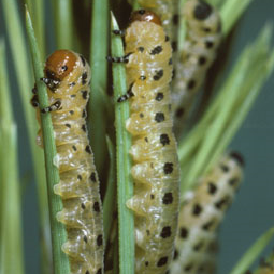Pines sawflies have been causing a lot of damage to pines in Douglas and Elbert counties. We have been getting a lot of phone calls from customers concerned about larvae defoliating their pines.
All this damage is caused by Redheaded pine sawflies (Neodiprion sertifer). Experts agree that they have never seen such a large population of
It feeds on two and three needle pines. The sawfly usually infests young and stressed pines. It produces two generations, with the spring generation stripping old needles before bud break and the summer generation consuming new needles. Larvae feed in colonies and can completely defoliate a pine from top to bottom. During heavy infestations pine sawfly can cause a lot of damage. It may defoliate and kill small pines.
•Natural. Different birds, parasites, and diseases kill larvae. Rodents feed on pupae in soil.
•
•Mechanical. You can prune branches with larvae. This method works when a small amount of colonies is present.
•
•Conventional insecticides may be needed when you have a heavy infestation of pine sawflies.
What you can do to save your trees. Start monitoring your pines on a regular basis. Look for egg spots on needles and for larvae from mid June to late July and again from mid August to late September.
If you notice presence of pine sawfly on your trees, give us a call. We will help you determine the best method of control.
The redheaded pine sawfly is an important pest. If not treated during heavy infestations, colonies of saw flies can partially or completely defoliate your pines which can result in trees’ mortality. They can weaken trees and make them vulnerable to other pests, like Ips beetles.
Comments are closed.